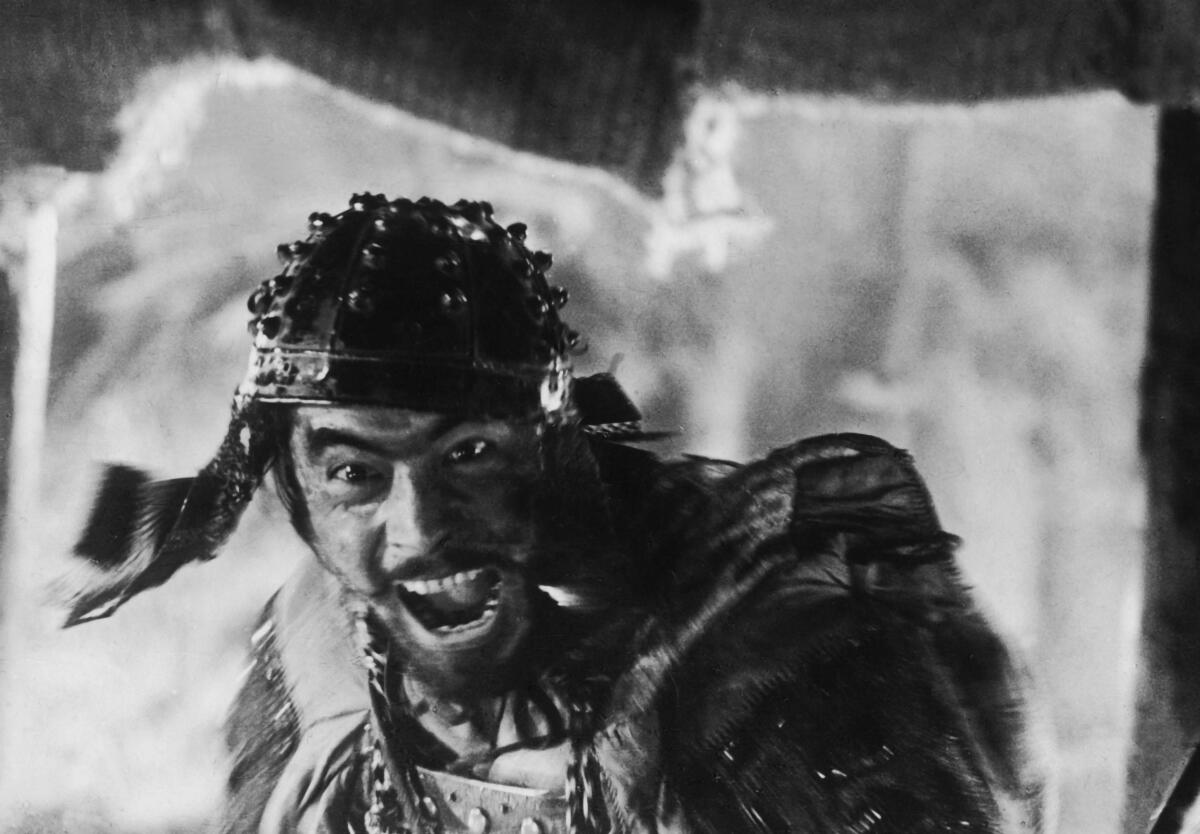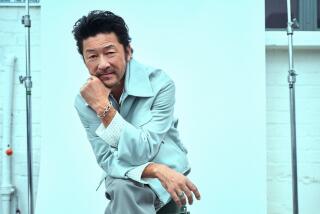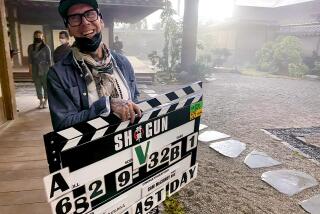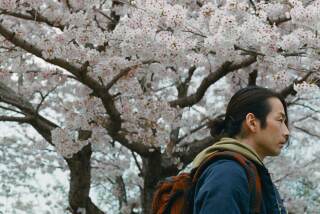Will ‘Ghost of Tsushima,’ one of the last games coming for PS4, honor samurai tradition?
- Share via
There is no shortage of films or games that draw some form of influence from samurai culture. And for “Ghost of Tsushima,” steeped heavily in classic samurai movie references and set to be one of the last major games to be released exclusively for Sony’s PlayStation 4 console, the developers aren’t running from comparisons.
The Bellevue, Wash., studio Sucker Punch, working in a storied genre known best for how it shaped action-adventure movies, fully embraces the history laid out by samurai culture. Yet “Ghost of Tsushima,” releasing July 17, is not a retro work.
With new consoles from Sony and Microsoft due later this year, “Ghost of Tsushima” aims to bring the PlayStation 4 era to a close with a work that shows interactive media’s evolving emotional complexity. It just happens to do so while extending a hand to a shared, cross-cultural nostalgia. The developers, for instance, spent a significant amount of time creating a grainy black-and-white mode for the game, one they intend to be no gimmick.
“The classic samurai films set many people’s expectations for what it is to be a samurai. They’re the way that we fell in love with the genre,” says Nate Fox, creative director of the game. “To honor that, to give people the same experience they have watching ‘Yojimbo,’ we wanted to be able to affect the graphics, to put them in a black-and-white film-grain scratch. We even adjusted the audio so it sounds more like one of those classic films. For people who are really purists, they’ll enjoy it. It’s us recognizing that these are the roots that we’re drawing from and we want to honor that.”
While film and games increasingly enjoy a symbiotic relationship, what works well in the interactive space doesn’t always provide lessons for a more passive medium and vice versa. Yet when it comes to “Ghost of Tsushima,” an adventure set in the late 13th century in which a samurai named Jin Sakai hopes to protect his island against a Mongol invasion, Fox believes games still have room when it comes to translating film’s emotional and narrative beats to the interactive space.
It’s often a matter of tone and pacing, elements that are created by game designers but, once a work is released, are manipulated, controlled or ignored by players. A scene Fox studied, he says, was a duel from Masaki Kobayashi‘s 1962 film “Harakiri,” where the build-up to a fight is just as important, if not more so, as the action that follows.
“In ‘Harakiri,’ there is a duel and the preamble for the duel is five minutes long,” says Fox. “It’s just two men walking through a graveyard, and then up a windswept hill. Then they look at each other and slowly draw their swords and the music finally starts. It is so thick with tension and expectation. The violence is actually not very long. But because of the landscape thrashing around these two men, who are still like statues, it is electrifying. This is something that could be, should be, put in an interactive medium. Movies like this are thick with things to try and transport from a cinematic medium into an interactive one.”
While a game may not naturally allow for such a curated direction when a player is controlling the action, Fox says the team at Sucker Punch attempted to craft combat in such a way that it forced players to take a measured approach. Part of that is allowing players to plot engagements with a heavy emphasis on stealth but also to traverse the landscapes and study enemies. If Sucker Punch gets it right, says Fox, “Ghost of Tsushima” will place an extremely strong emphasis on timing, as combat hopes to be exact, and a misread of a set piece should be fatal.
“There are two things that make a samurai sword battle feel like a samurai movie. One,” says Fox, “is respecting the lethality of the sword. With one or two strikes you can drop an opponent; with one or two strikes you yourself can be killed. That is typical of the films and makes the combat feel very deadly.
“The second thing,” he continues, “that really makes a fight feel like a samurai battle is stillness. Warriors are not just attacking crazily. They’re waiting and watching each other’s motions. There’s anticipation. When the swords do move, the sword moves with precision. The game rewards looking at what an enemy is doing, pushing the attack if it’s right or waiting to respond if it’s not. When you make your move, Jin, our hero, doesn’t breathe heavy and move around. He stays still and just moves his head ever so slightly. There’s complete economy of motion.”
Ellie takes the lead in “The Last of Us” sequel, fighting zombies and her own feelings for Dina. And there’s a twist to your test over whether to kill those dogs.
Combat, not surprisingly, is perhaps where the Sucker Punch team pulled from the most modern of influences. In swordplay, Fox cites Takashi Miike’s 2010 retelling of “13 Assassins,” a film The Times praised for its ability to “juxtapose cruelty and beauty.”
“When we were making combat we went off three words: mud, blood and feel. We want the combat to feel incredibly visceral, dirty and deadly. If you watch ’13 Assassins,’ that is the touchstone there. They treat swords with respect. Those swords are sharp and people are fighting for their lives,” Fox explains.
He can go through a number of his favorite samurai films and trace their impact on “Ghost of Tsushima.”
Take Akira Kurosawa’s 1961 film “Yojimbo,” in which a master swordsman comes upon a town and manages to play multiple evil factions against one another. “Ghost of Tsushima” hopes to capture that sensation of being a solo wanderer who can stumble into characters and conflicts outside the main story, for instance, following a forest creature who can lead to new narrative strands.
“‘Yojimbo’ is a good representation of what it’s like to wander the countryside and come upon adventure. ‘Ghost of Tsushima’ is a big game, and while there is a tale of Jin’s transformation to warrior, you can go off of the main narrative path and get to know these other characters who have their own problems,” Fox says. “The game is a big anthology of stories. ‘Yojimbo’ shows how that would work.”

Then, of course, there’s perhaps the best known samurai movie of them all: Kurosawa’s 1954 classic, “Seven Samurai,” which manages to tell a number of personal stories amid its overriding tale of mercenaries who are hired to protect a farming village. Here, like other action-adventure games that alternate quiet, contemplative moments with those of violence, “Ghost of Tsushima” attempts to show the personal toll such deeds can take.
“‘Seven Samurai’ is the most important film to me, personally,” Fox says, “because it shows the samurai treating everybody with intense respect, and feeling as if it is their duty to protect the people. They selflessly sacrifice themselves, and as a result you feel they are operating on a higher level. That is something that is directly put into ‘Ghost of Tsushima,’ that sacrifice.”
Jin, says Fox, will have to rethink what it means to be a samurai, getting mixed up in “all sorts of gruesome business because the odds are stacked against him. If he doesn’t do anything, if he just protects his own concept of self, the people of his island all die. So this is the story of sacrifice.”
Of course, Fox doesn’t deny that he and his collaborators at Sucker Punch are a “bunch of Americans who just like samurai movies.” Since the game was announced a few years back, Sucker Punch has talked up the studio’s parent company, Sony, as providing easy access to Japanese studios and artists who could either correct any wrong assumptions of the Pacific Northwest developers or lead them to experts who could put them on the right cultural path.
Fox hopes that helped imbue “Ghost of Tsushima” with a respectful, authentic tone. As an example, he says the studio aimed to reflect the meaning behind any Japanese imagery it shows in the game. He cites the reddish-orange torii gates that Westerners are often introduced to via postcards from Japan or other tourist paraphernalia, which serve as gateways to sacred Shinto shrines.
“That gate is something that has all this meaning attached to it, and I didn’t know that when we started this game,” Fox says. “And now it’s something we put in the game, and they do all lead to Shinto shrines. Players who play this game will get that extra transportive quality by learning about the things we learned while making the game.”
More to Read
The biggest entertainment stories
Get our big stories about Hollywood, film, television, music, arts, culture and more right in your inbox as soon as they publish.
You may occasionally receive promotional content from the Los Angeles Times.











